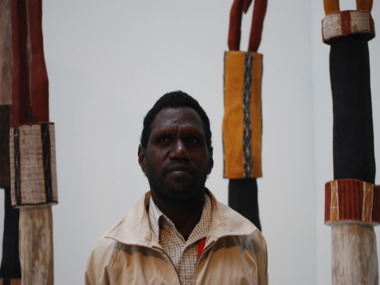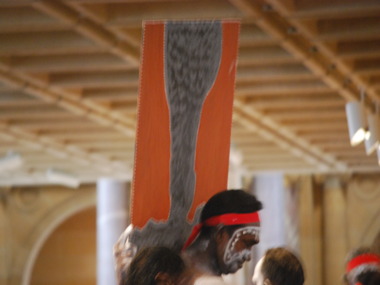HETTI'S MULTI-MEDIA PROJECT

Pedro Wonaeamirri in front of his Pukumani Poles at AGNSW
Aboriginal Art Directory | 07.10.10
Author: Jeremy Eccles
Bigger than Ben Hur (which is soon to be at a football stadium near you)!
Hetti Perkins, Senior Curator of Aboriginal and Torres Strait Islander Art at the Art Gallery of NSW, turns out to be a gentle, girlish guide to the wonderful art of her people in a project which grew like Topsy from a series of interviews with artists to a TV series, a major book and an exhibition of connected art at her home Gallery in Sydney.
On TV – from tonight and for the next two Thursdays – Art + Soul offers a delightful introduction to the art and many of the issues around the painting: its vital importance in remote communities and its personal politics in the cities. But no one's claiming it as a definitive portrait of the movement in 2010, for, as Perkins herself admits, “when the project finally came together in a rush in late 2008, there was just no time to build relations with new people. So everyone on screen is a friend – giving me personal and intimate access. The links between them are imaginative ones – all in my own mind. But this does mean that regions like the APY Lands and the west Kimberley aren't there – I just didn't know them well enough”.
That's the price one has to pay for getting such a generous sense of Hetti Perkins' progress from her relatively privileged start as one of the children of such a high profile sporting and political figure as Charlie Perkins. Old film of the family visiting the miserable Papunya settlement from which such great art had yet to flow, the Perkins kids in their smart city outfits, is ironic; and Hetti's image today as “such a Sydney girl”, is gently gypped by her friend Destiny Deacon. Deacon continues the mockery by teaching the woman, who quickly gets back on message by acknowledging Aranda country as “my home”, how to cook 'Mission Stew'!
What emerges from behind Hetti's descriptions of having her “ego knocked out of the way” in two or three such episodes is the realisation that what appears to be a solo journey is as much the product of the amazing Warwick Thornton's directorial and editorial decision-taking. And, as with his Cannes prize-winning feature film 'Samson & Delilah', one simply can't ignore his cinematographic skills as well. There are desert sunrises and seaboard sunsets to die for in the remote scenes in this series; as well as magic moments with artists that could only have been captured by an exceptionally alert and patient camera. As Perkins describes it, “We spent two days with the Hermannsburg ladies, and they were just great to be with. But they don't say much! And they'll often only answer a question half an hour after you've asked it!”.
Which raises the question of what feels like an inbalance in which the 9 Blak artists who appear in the films seem to outnumber the 29 remote artists. It's obviously been a lot easier to get Perkins' friends from her earliest days as an urban artist herself at the Boomali cooperative in Sydney to talk than it is the remote artists hampered by lack of English. True a cross-cultured man like Rusty Peters in Warmun can communicate some of the pain of his massacre paintings or the complexity of his amazing 7-panel 'Waterbrain' work covering the Gija life-cycle. But it's only in their own language that most are comfortable – as Warlimpirrnga Tjapaltjarri shows us so well at his camp outside Kiwirrkurra.
So there's little doubt that the most effective scenes in the series are with Blak artists like HJ Wedge and Ricky Maynard – not forgetting the ebullient Destiny Deacon. Both the men, though are moving in their revelations of early alcoholism and the influence of their art in re-empowering themselves and their people. Maynard's unforgettable photo of himself standing in the sea looking across the Bass Strait to his Tasmanian country ('Broken Heart', 2005) is particularly well contextualised. And Wedge's touching link between Australia as a “Garden of Eden destroyed by white people over 200 years” to his own childhood in his grandfather's garden makes such sense of a painted world that's full of “little consciences”. There's also a telling personal link to Boomali days of Hetti helping to write down the stories behind this illiterate man's early paintings.
Meanwhile, out bush, there's plenty of painting in the red dust, loading and unloading of four-wheel drives, crackling fires and intense singing. “The remote experience we've been able to offer will be so special for most people”, assesses Perkins. Mind you, that singing also occurs magically in the AGNSW – where much of the art was photographed under ideal circumstances - when, in an archival interview with the late Mr Giles, he recognises the country in a Ronnie Tjampitjinpa painting on the wall and breaks into song. More history is put on the record through episodes about Tommy McRae, Albert Namatjira, Rover Thomas, Emily Kngwarreye, Lin Onus and Michael Riley. How could they leave any of them out?
There's a faint suspicion that the first two programs in the TV series – Home+Away and Dreams+Nightmares – are but sucker-punches leading you into the more political third - Bitter+Sweet. And this is confirmed by the more complete text offered in the Miegunyah Press 'companion' to the TV series. Charlie Perkins and the Foundation for Aboriginal Affairs open the batting there by questioning the universality of 'Lest We Forget' memorials all over a country that maintains a 'Great Silence' about the far greater number of Aboriginal deaths. Then even art politics turn feisty with Hetti's swipe at the Heidleberg School's “representations of the pioneering spirit seem(ing) to present a morally suspect brand of nationalism”.
The AGNSW exhibition is open and runs until Feb 13th 2011. The TV series will be on ABC 1 on 7/14/21 October. And there's a website with more material at http://www.abc.net.au/arts/artandsoul/flash/default.htm . The splendid Miegunyah Press book costs $79.99.
URL: http://www.abc.net.au/arts/artandsoul/flash/default.htm
Share this:
»  del.icio.us
»
del.icio.us
»  Digg it
»
Digg it
»  reddit
»
reddit
»  Google
»
Google
»  StumbleUpon
»
StumbleUpon
»  Technorati
»
Technorati
»  Facebook
Facebook
Contact Details
Gallery: Art Gallery of NSW
Contact: Cara Pinchbeck - Curator of Aboriginal and Torres Strait Islander Art
Email: artmail@ag.nsw.gov.au
Telephone: +61 2 9225 1700 or 1
Address: Art Gallery Road Sydney Sydney 2000 NSW

Dancers from Warmun perform the famous Gurirr Gurirr Ceremony at the Opening Weekend of Art + Soul, AGNSW
Further Research
Gallery: Art Gallery of NSW
Artists: HJ Wedge | Albert Namatjira | Destiny Deacon | Emily Kngwarreye | Lin Onus | Michael Riley | Ricky Maynard | Ronnie Tjampitjinpa | Rover Thomas | Rusty Peters | Tommy McRae | Warlimpirrnga Tjapaltjarri
News Tags: art + soul
News Categories: Book
News Archive
- 11.10.17 | RETURN OF MUNGO MAN
- 10.10.17 | TARNANTHI 2017
- 11.08.17 | Natsiaas 2017
- 08.08.17 | ABORIGINAL ART ECONOMICS
- 02.08.17 | SCHOLL'S NEXT MOVE
- 20.07.17 | APY ART DOMINATES THE WYNNE
- 17.07.17 | Anangu Artist Wins $100,000 Prize
- 14.07.17 | The End of AAMU
- 13.07.17 | YOU ARE HERE
- 11.07.17 | ART ACROSS THE COUNTRY
- 11.07.17 | TARNANTHI IN OCTOBER
- 05.07.17 | TJUNGUṈUTJA - from having come together
- 02.07.17 | BENNELONG
- 27.06.17 | JIMMY CHI
- 23.06.17 | Blak Markets at Barangaroo
Advertising

